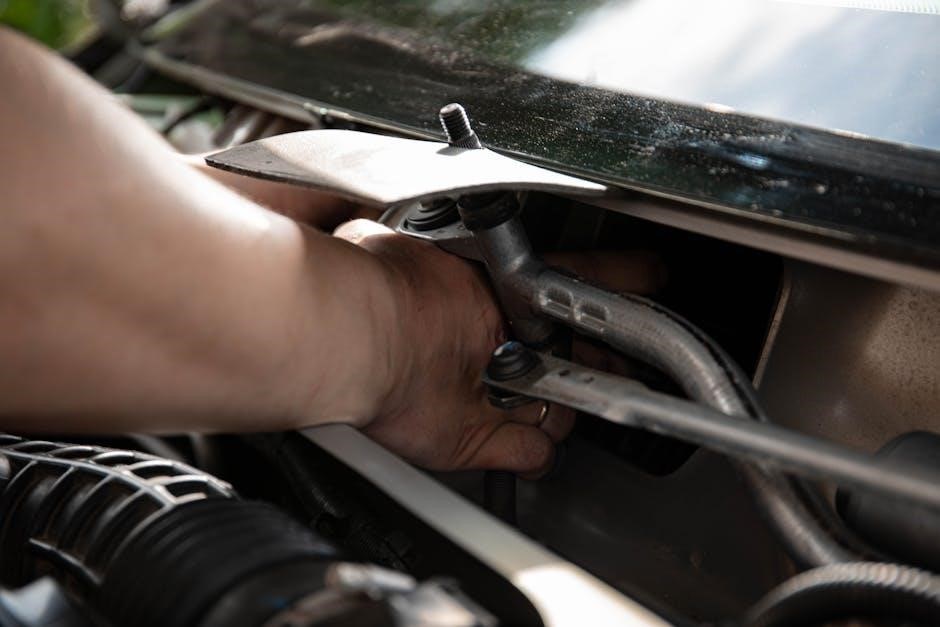The Maxi-Cosi Pebble 360 Pro is a premium car seat designed for safety and comfort, suitable from birth to 15 months. It features 360-degree rotation, recline functionality, and i-Size compliance, with a comprehensive manual for easy installation and use.
Overview of the Maxi-Cosi Pebble 360 Pro Car Seat
The Maxi-Cosi Pebble 360 Pro is a state-of-the-art car seat designed for infants and toddlers, offering unparalleled safety and comfort. It is suitable for use from birth up to approximately 15 months or until your child reaches 87 cm in height and 13 kg in weight. This car seat features a 360-degree rotation mechanism, allowing for effortless and convenient access when securing your child. The Pebble 360 Pro is compatible with the FamilyFix 360 Pro base, which simplifies installation and removal. It also boasts a lie-flat position, providing maximum comfort for your baby during long journeys. The seat is lightweight and portable, making it easy to transfer between vehicles or use as part of a travel system with compatible strollers. With its sleek design and advanced features, the Pebble 360 Pro ensures a safe and comfortable experience for your child, while its i-Size (R129/03) certification guarantees compliance with the latest safety standards.
Key Features and Benefits of the Pebble 360 Pro
The Maxi-Cosi Pebble 360 Pro stands out for its 360-degree rotation, enabling easy access to your child without straining your back. This feature also simplifies installation and ensures proper positioning in the vehicle. The seat is designed with i-Size (R129/03) compliance, offering enhanced side-impact protection and crash test performance. Its lie-flat position promotes healthy spine development and comfort during long drives. The Pebble 360 Pro is lightweight, making it easy to carry, and features an aerated fabric for breathability, keeping your child cool in warmer conditions. Additionally, the Click & Go installation with the FamilyFix 360 Pro base ensures a secure and quick fit. The seat also includes an adjustable harness and headrest, growing with your child for a perfect fit. The SPHERE technology absorbs forces in case of an impact, providing maximum safety. These features combine to create a car seat that prioritizes safety, comfort, and convenience for both parents and babies.

Installation Instructions for the Maxi-Cosi Pebble 360 Pro
The Maxi-Cosi Pebble 360 Pro offers versatile installation options, ensuring a secure and convenient setup. Begin by selecting the desired installation method—either using the ISOFIX base or the vehicle’s 3-point seat belt. For ISOFIX installation, attach the FamilyFix 360 Pro base to the vehicle’s ISOFIX anchorage points until it clicks securely into place. Once the base is installed, simply click the Pebble 360 Pro into position and use the 360-degree rotation feature to face the seat towards the door for easy access. For seat belt installation, thread the vehicle’s 3-point belt through the designated guides on the car seat and tighten firmly to ensure a snug fit. Always verify compatibility with your vehicle and check that the seat does not move more than an inch in any direction. Lock the 360-degree rotation mechanism while driving for added stability. Refer to the user manual for detailed steps and safety precautions to ensure a safe and proper installation.
Step-by-Step Guide to Installing the Pebble 360 Pro with ISOFIX Base
Ensure your vehicle is equipped with ISOFIX anchorage points. Begin by unfolding the FamilyFix 360 Pro base and positioning it on the vehicle seat. Align the ISOFIX connectors with the vehicle’s anchorage points and push the base firmly until it clicks into place. Tighten the base by pulling the ISOFIX straps until it feels secure. Next, attach the Pebble 360 Pro car seat to the base by clicking it into position. Use the 360-degree rotation feature to turn the seat towards the door for easier access. Ensure the seat is locked in place by engaging the rotation mechanism. Check that the seat does not move more than 1 inch in any direction; Tighten the base and seat connection if necessary. Finally, secure your child by fastening the harness and adjusting it to fit snugly. Always refer to the user manual for specific compatibility checks and additional safety precautions. Proper installation ensures maximum safety and comfort for your child.
How to Install the Pebble 360 Pro Using the Vehicle’s 3-Point Seat Belt
Begin by placing the Pebble 360 Pro car seat in the vehicle, ensuring it is positioned upright and centered. Locate the vehicle’s 3-point seat belt and thread the lap belt through the designated belt guides on the car seat. Ensure the belt is flat and not twisted. Next, insert the buckle into the seat belt receptor and pull the shoulder belt across the seat to secure it. Tighten the seat belt firmly by pulling the webbing until the car seat is held snugly in place. Check the seat for stability by gently rocking it; it should not move excessively. Use the integrated seat belt tensioner on the Pebble 360 Pro to further secure the seat if needed. Finally, verify that the seat belt is correctly fastened and that the car seat is stable. Always refer to your vehicle’s manual for specific seat belt routing instructions and ensure the installation meets safety standards. Regular checks are recommended to maintain a secure fit.
Understanding the 360-Degree Rotation Feature for Easy Installation
The Maxi-Cosi Pebble 360 Pro features a 360-degree rotation mechanism designed to simplify installation and daily use. This innovative feature allows parents to swivel the car seat effortlessly, making it easier to position the seat correctly in the vehicle. To use the rotation feature, first ensure the seat is securely attached to the ISOFIX base. Once installed, gently turn the seat in the desired direction using the convenient turning handle located at the base. This feature is particularly useful for installing the seat without straining or adjusting the vehicle’s seat repeatedly. The 360-degree rotation also allows easy access to secure your child or adjust their position without compromising safety. The seat locks into place in both forward- and rear-facing positions, ensuring stability and proper installation. This feature enhances convenience while maintaining the car seat’s safety and functionality, making it a practical solution for busy parents.

Safety Features of the Maxi-Cosi Pebble 360 Pro
The Maxi-Cosi Pebble 360 Pro offers advanced safety features, including i-Size compliance, 360-degree rotation for easy installation, and shock-absorbing materials. It provides superior side impact protection and a durable design for reliable safety.
Compliance with i-Size (R129/03) Safety Standards
The Maxi-Cosi Pebble 360 Pro is fully compliant with the i-Size (R129/03) safety standards, ensuring enhanced protection for children from birth up to approximately 12 months (or 75 cm in height). i-Size regulations focus on improved crash performance, better side impact protection, and a more stringent testing process. The Pebble 360 Pro meets these standards by incorporating advanced safety features, such as a robust shell design and energy-absorbing materials, to minimize the risk of injury in the event of an accident. Additionally, the seat’s 360-degree rotation simplifies installation and ensures correct positioning, which is critical for safety. The i-Size certification also verifies that the seat provides better legroom and comfort for growing babies, while its compatibility with ISOFIX bases ensures a secure and stable fit in the vehicle. By adhering to these rigorous standards, the Pebble 360 Pro offers parents peace of mind and confidence in their child’s safety on the road.
Advanced Safety Features for Maximum Protection
The Maxi-Cosi Pebble 360 Pro is equipped with advanced safety features designed to provide maximum protection for your child in the event of an accident. One of its standout features is the Side Protection System (SPS), which offers superior protection against side impacts by absorbing and distributing crash forces away from your child. Additionally, the seat’s shell is crafted from high-quality, durable materials that provide excellent structural integrity and energy absorption.
The Pebble 360 Pro also incorporates Tri-Protect® technology, which combines the seat’s shell, cushion, and harness to offer three layers of protection. The 360-degree rotation feature not only simplifies installation but also ensures that your child can be positioned correctly, further enhancing safety. Furthermore, the seat’s anti-rotation leg on the ISOFIX base prevents excessive movement during a crash, ensuring stability and protection.
These advanced safety features, combined with rigorous testing and adherence to safety standards, make the Pebble 360 Pro a reliable choice for parents seeking optimal protection for their child.

Adjusting and Customizing the Maxi-Cosi Pebble 360 Pro
The Pebble 360 Pro offers multiple recline positions for your child’s comfort. The harness and headrest can be adjusted to grow with your child, ensuring a perfect fit. The 360-degree rotation simplifies getting your baby in and out.
Additional customization options include soft, breathable fabrics and color-coded straps for easy adjustment. The seat also features integrated storage for small accessories, keeping everything within reach while maintaining a clean design.
How to Recline the Seat for Optimal Comfort
To recline the Maxi-Cosi Pebble 360 Pro, locate the recline handle at the base of the seat. Gently pull the handle upward while leaning the seat backward to your desired position. The seat offers multiple recline positions, allowing you to customize your baby’s comfort.
Ensure the seat is securely locked into place after adjusting. For newborns, a more upright position may be preferred, while older babies might benefit from a slightly reclined angle. Always check the seat’s stability and alignment with the vehicle’s seat.
The recline feature is designed to promote safe and comfortable sleep during journeys. Regularly inspect the recline mechanism to ensure it functions smoothly and refer to the user manual for specific guidance tailored to your model. Proper adjustment ensures your child’s safety and comfort.
Adjusting the Harness and Headrest for Proper Fit
To ensure your child’s safety and comfort, properly adjust the harness and headrest of the Maxi-Cosi Pebble 360 Pro. Begin by loosening the harness straps using the adjustment buckle at the bottom of the seat. Position your child in the seat, ensuring their shoulders are aligned with the markers on the seat shell.
Tighten the harness straps evenly, ensuring they are snug but not overly tight. The red clip should sit at your child’s armpit level. Next, adjust the headrest by sliding it up or down until it is level with the top of your child’s ears. This ensures proper support and protection.
Regularly check the fit as your child grows, making adjustments as needed. Avoid overtightening, as this could cause discomfort. Always refer to the user manual for specific guidelines on harness and headrest adjustment for your model. Proper fit is crucial for both safety and comfort during travel.
Maintenance and Care of the Maxi-Cosi Pebble 360 Pro

Regularly clean the fabric with a soft cloth and mild detergent. Inspect for wear and tear, and replace damaged parts. Store in a dry, cool place when not in use.
Cleaning Instructions for the Car Seat and Accessories
To maintain the Maxi-Cosi Pebble 360 Pro, clean it regularly using a soft cloth and mild detergent. Avoid harsh chemicals or abrasive cleaners, as they may damage the materials. For the fabric, gently wipe away dirt or spills with a damp cloth. Do not soak or machine wash the fabric, as this could compromise its safety features. For tougher stains, mix a small amount of mild soap with warm water and gently scrub the area. Rinse thoroughly with a clean, damp cloth to remove any soap residue. Allow the seat to air dry completely before use. For the harness and buckle, clean with a damp cloth and avoid using any soap or bleach. Regularly inspect the seat for signs of wear and tear, such as frayed straps or cracks in the shell. Replace any damaged parts immediately to ensure optimal safety. Cleaning the car seat and accessories regularly helps maintain its quality and longevity.
Storage Recommendations to Maintain Quality
When storing the Maxi-Cosi Pebble 360 Pro, place it in a cool, dry environment away from direct sunlight. Avoid storing it in attics, basements, or areas prone to humidity or extreme temperatures, as this could damage the materials. If the car seat is not in use for an extended period, ensure it is clean and dry before storage to prevent mold or mildew. Store the seat in its original packaging if available, as this provides protection against dust and scratches. Do not stack heavy objects on top of the car seat, as this could cause structural damage. For accessories like the ISOFIX base or harness, store them separately in a protective bag or box. Before reusing the car seat after storage, inspect it for any signs of damage or wear. Ensure all components are securely attached and functioning properly. Proper storage helps maintain the quality and safety of the Maxi-Cosi Pebble 360 Pro for future use.

Compatibility and Usage Guidelines
- The Maxi-Cosi Pebble 360 Pro is compatible with vehicles featuring ISOFIX mounting points or a 3-point seat belt for secure installation and easy rotation.
- It can be used with compatible strollers, adapting to your lifestyle, and supports children from birth up to 12 months or 13 kg.

Vehicle Compatibility and Space Requirements

Ensure your vehicle is compatible with the Maxi-Cosi Pebble 360 Pro before installation. This car seat is designed to fit securely in vehicles equipped with ISOFIX mounting points or a 3-point seat belt system. Always check your car’s manual to confirm ISOFIX compatibility or seat belt installation options.
- The Pebble 360 Pro requires adequate space for proper installation, especially when using the 360-degree rotation feature. Measure your vehicle’s backseat to ensure sufficient room for the seat to rotate fully.
- For vehicles without ISOFIX, the seat can be installed using the vehicle’s 3-point seat belt. Ensure the belt can securely hold the seat in place without twisting or slack.
- Consider the car seat’s dimensions (approximately 69 cm tall and 44 cm wide) to ensure it fits comfortably in your vehicle, especially in smaller cars or when multiple seats are installed.
- Always follow the manufacturer’s guidelines for weight and size limits, as the Pebble 360 Pro is designed for children up to 13 kg (approximately 12 months).
For optimal safety and functionality, verify your vehicle’s compatibility and measure the space before installing the Maxi-Cosi Pebble 360 Pro.
Using the Pebble 360 Pro with Compatible Strollers

The Maxi-Cosi Pebble 360 Pro is designed to seamlessly integrate with compatible strollers, offering a convenient travel solution for parents. To use the car seat with a stroller, ensure the stroller is part of the Maxi-Cosi compatibility list or compatible with the Pebble 360 Pro adapter. This ensures a secure and stable connection.
- First, attach the car seat adapters to the stroller according to the manufacturer’s instructions. These adapters will hold the Pebble 360 Pro firmly in place.
- Once the adapters are installed, simply click the car seat onto the stroller. You’ll hear a distinct click to confirm it’s securely attached.
- Always perform a safety check by gently tugging the seat to ensure it’s properly locked in position.
- When using the Pebble 360 Pro on a stroller, ensure your child is harnessed correctly and the stroller is stable to prevent tipping.
This feature provides a smooth transition from car to stroller, making daily outings with your baby effortless and stress-free.
Additional Resources for the Maxi-Cosi Pebble 360 Pro
Explore the full user manual and quick start guide for detailed instructions.
Visit the official Maxi-Cosi website or YouTube channel for instructional videos and troubleshooting tips.
Accessing the Full User Manual and Quick Start Guide
To ensure safe and proper use of the Maxi-Cosi Pebble 360 Pro, access the full user manual and quick start guide provided with your purchase. These resources are designed to guide you through installation, adjustment, and maintenance.
The full user manual offers comprehensive details on all features, safety standards, and troubleshooting tips. The quick start guide provides a concise, step-by-step overview for initial setup and everyday use.
Both documents are included in the product packaging. Digital versions are also available on the official Maxi-Cosi website. For easy access, download the PDF versions to your smartphone or tablet for on-the-go reference.
Reviewing these materials ensures you understand how to use the 360-degree rotation, ISOFIX base, and harness system correctly. They also cover compatibility with vehicles and strollers, helping you make informed decisions.
Additional resources, such as instructional videos, are available online to complement the manual. Always refer to these guides to maximize safety and convenience for your child.
Watching Instructional Videos for Installation and Usage
Maxi-Cosi provides instructional videos to help you master the installation and usage of the Pebble 360 Pro. These videos are designed to complement the user manual and offer a visual guide for a smoother experience.
Available on the official Maxi-Cosi website and YouTube channel, these videos cover topics such as ISOFIX base installation, seat belt configuration, and harness adjustment. They also demonstrate how to utilize the 360-degree rotation feature effectively.
Watching these videos can clarify complex steps and ensure you’re using the car seat correctly. Additionally, they provide tips for maintaining the seat and troubleshooting common issues. For the best experience, watch the videos on a larger screen and pause as needed to follow along.
These resources are especially helpful for first-time users or those unfamiliar with car seat installation. By following the videos, you can ensure the Pebble 360 Pro is set up safely and efficiently, giving you peace of mind while traveling with your child.
Troubleshooting Common Issues
Troubleshooting the Maxi-Cosi Pebble 360 Pro involves checking the ISOFIX base, ensuring proper harness tightness, and verifying correct installation. If issues persist, refer to the user manual or contact customer support.

Resolving Common Problems with Installation or Adjustment
Common issues with the Maxi-Cosi Pebble 360 Pro often relate to installation or adjustment. Ensure the ISOFIX base is correctly clicked into place and check that the support leg is properly adjusted. If the seat feels unstable, verify that the base is securely fastened to the vehicle floor. For harness issues, make sure it is tightened evenly and not twisted. If the seat does not rotate smoothly, inspect for obstructions or incorrect belt routing. Adjust the recline position to ensure the seat is level and fits your vehicle’s seat contour. If problems persist, consult the user manual or reset the seat by removing and reinstalling it. Always double-check the vehicle compatibility list to ensure proper fitment. Regularly inspect the seat and base for damage or wear. If issues remain unresolved, contact Maxi-Cosi customer support for assistance.
Frequently Asked Questions About the Pebble 360 Pro
- What is the weight and age range for the Pebble 360 Pro? It is suitable for babies from birth up to approximately 12 months (or 13 kg).
- Can the Pebble 360 Pro be used without the ISOFIX base? Yes, it can be installed using the vehicle’s 3-point seat belt, but the ISOFIX base is recommended for added stability.
- Is the Pebble 360 Pro compatible with all vehicles? No, check the compatibility list in the manual to ensure it fits your vehicle’s make and model.
- Can the seat be used in airplanes? Yes, it is approved for use in aircraft when installed with the vehicle seat belt.
- How do I clean the seat covers? Remove and machine wash at 30°C, avoiding bleach or harsh chemicals.
For more details, refer to the user manual or contact Maxi-Cosi customer support.























































